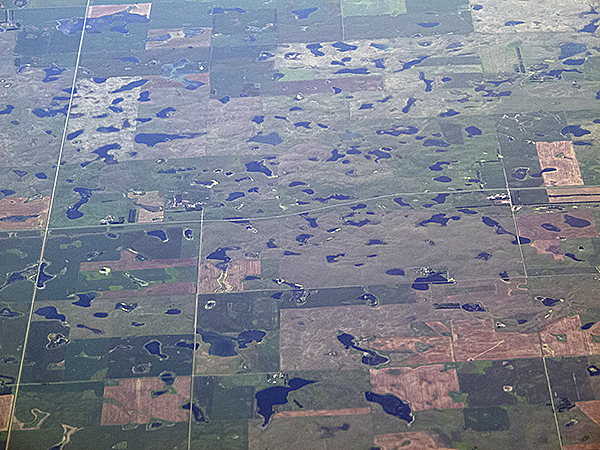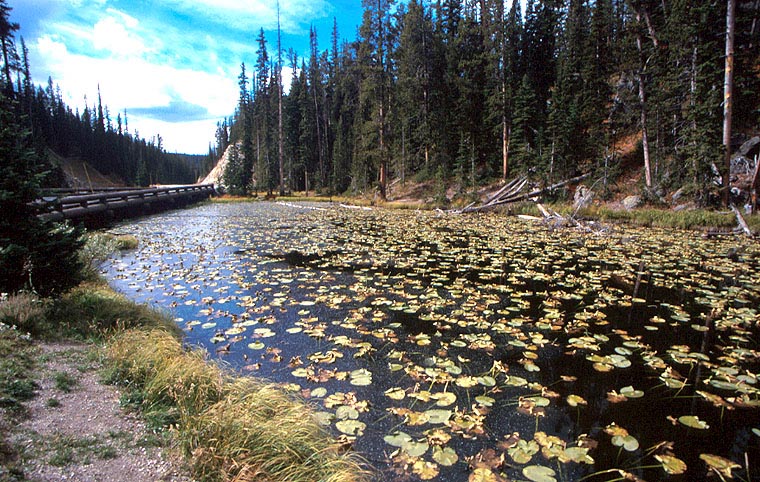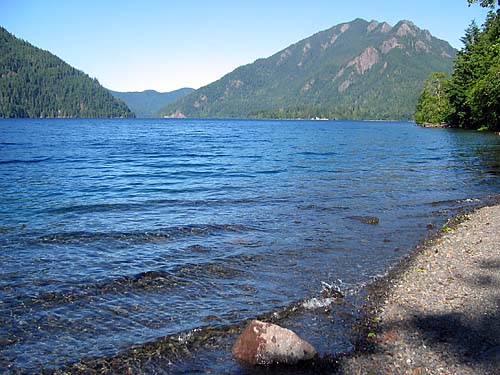
One way of thinking of lakes and ponds is that they are merely slow spots in streams and rivers. This is Avalanche Lake in Glacier National Park, Montana. Water from the glaciers in the background pool temporarily in this depression (which was scooped out by a glacier long ago) before cascading down through the mountains in the waters of Avalanche Creek (below left).
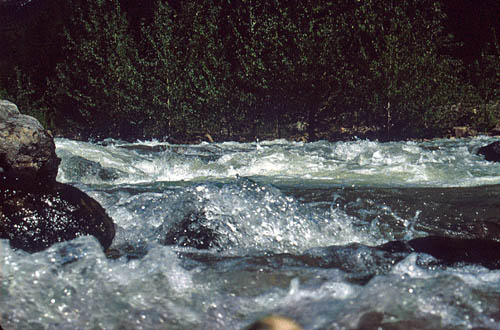

To the right is May Lake, high in the Sierra Nevada of California in Yosemite National Park. This lake receives its water from snowmelt off the adjacent rocky slopes. As you might guess, the snow and rain are not able to dissolve many minerals from the igneous rocks of the Sierra and as a result, May Lake is oligotrophic. Oligotrophic means having few nutrients just as oligarchy is rule by a few people. These high lakes have exceptionally clear water (see the curve for Lake Tahoe in the graph below). On the other hand, with few nutrients there is also little production and these lakes cannot support much biomass. Also, with few dissolved minerals in them, such high-altitude lakes often have little buffering capacity, and are thus very susceptible to acid precipitation.
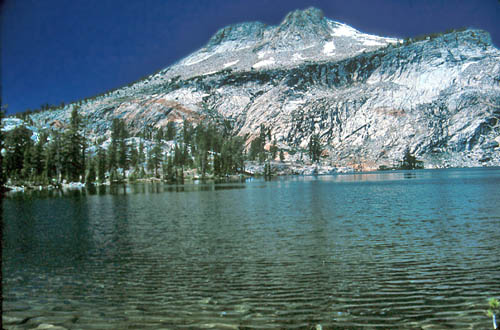

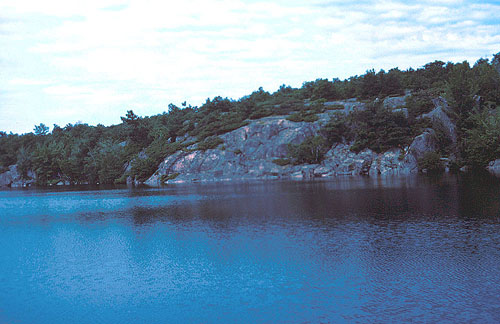
Haley Lake, Ontario, Canada

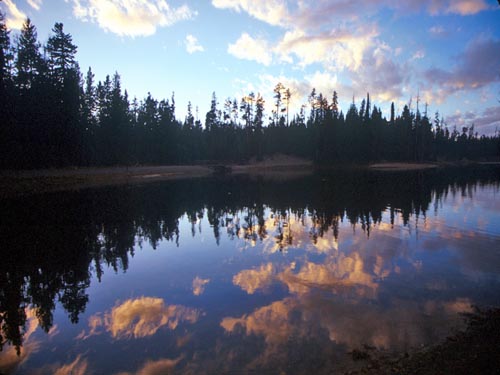

MacDonald Lake, Glacier National Park, Montana
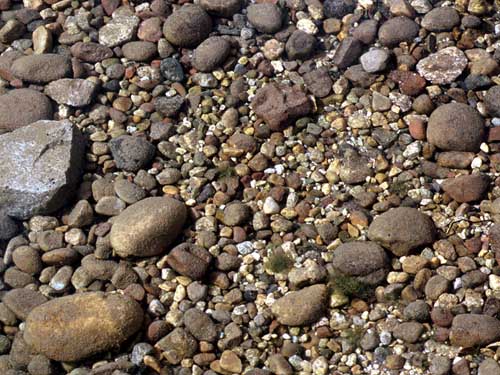

Jenny Lake (left), Grand Teton National Park, Wyoming (right, Jackson Lake in Foreground)
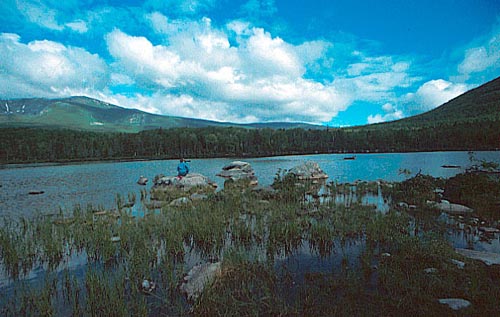
Sandy Stream Pond, Baxter State Park, Maine
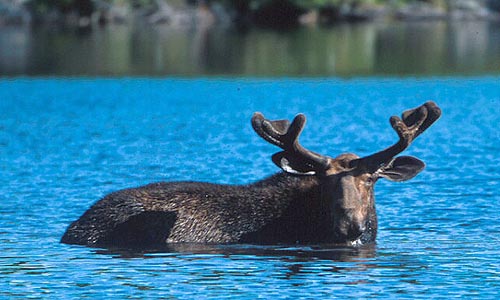

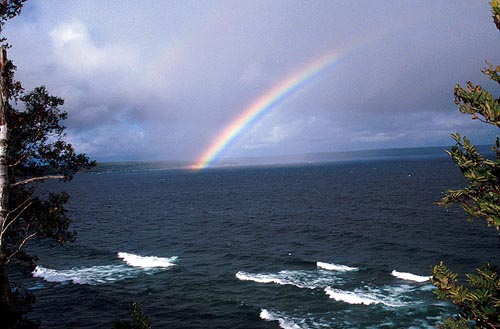
Lake Superior
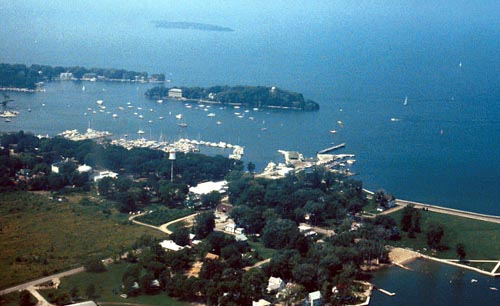
Put-in-Bay, Lake Erie
The Lauretian Great Lakes - Superior, Huron, Michigan, Erie and Ontario - comprise one of the greatest freshwater systems on the planet. Ranging from deep, cold oligotrophic Lake Superior in the north to shallow, eutrophic Lake Erie in the south, there are a range of aquatic habitats here. The size of the lakes means they have processes that are sometimes more akin to what happens in the ocean than what you would expect in a lake. For instance, the extensive sandy spit off the southern point of Pelee Island (lower right) moves about mush the same way that barrier islands on the eastern coast of the US do. On the other hand, the western part of Lake Erie is very shallow - only about 10m or so deep on average - and spotted with islands, including Pelee Island, South Bass Island, and Gibraltar Island, home of the Franz Theodore Stone Laboratory, operated by Ohio State University. The oldest biological field station in the United States, Stone Lab has done much to document the changes in Lake Erie as developing agriculture in Northwestern Ohio, as well as burgeoning cities such as Detroit, all added nutrients to the lake, culminating in extensive areas of anoxic sediments in the 1950's and the widely reported "death" of Lake Erie (actually the lake had more living biomass then than it did at any other time). The western part of Lake Erie is often called river like because the invertebrate species and plankton dynamics are more like a wide river than a lake.

Gibraltar Island, Stone Research Laboratory, Put-in-Bay, Lake Erie
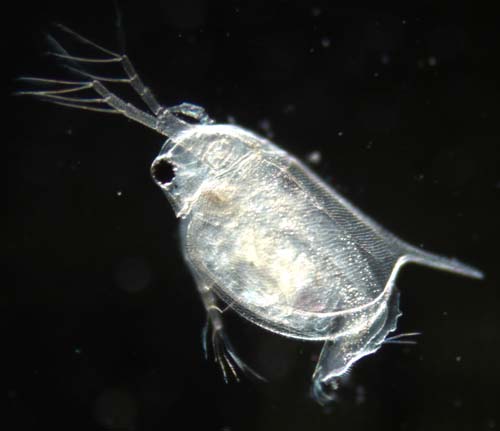
Daphnia sp.
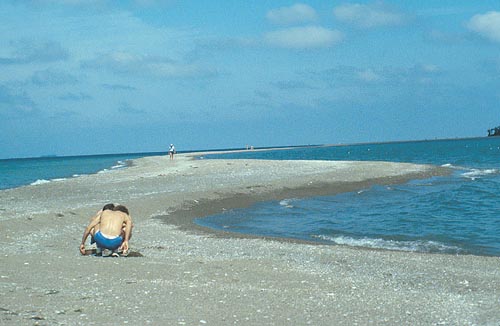
Pelee Island, Ontario Canada

Aboard the RV Hydra on Lake Erie.

A real Hydra.
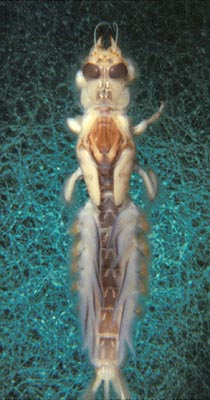
Burrowing Mayfly (Ephemeridae). These larvae dominated the bottom sediments of Lake Erie until it went anoxic in the fall of 1953, killing the approximately 240 mayfly larvae per square meter on most of the bottom of the lake.
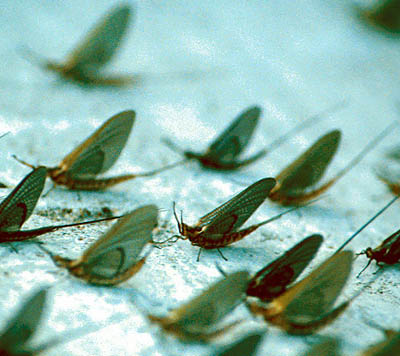
Burrowing Mayfly adults swarming on the front of the Stone Lab building, 1981.
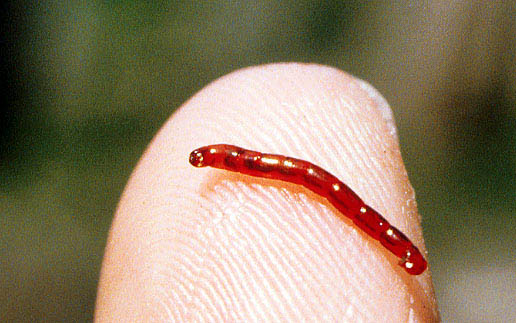
Midge Larvae (Chironomidae). Midge larvae largely replaced the mayflies on the bottom of Lake Erie from 1953 through the 1990's, when the mayflies began a strong comeback. The red is hemoglobin, which allows the midge larvae to attract and store oxygen, a useful trait in anoxic sediments.


Burrowing Mayfly adults swarming on the front of the Stone Lab building, 1981.
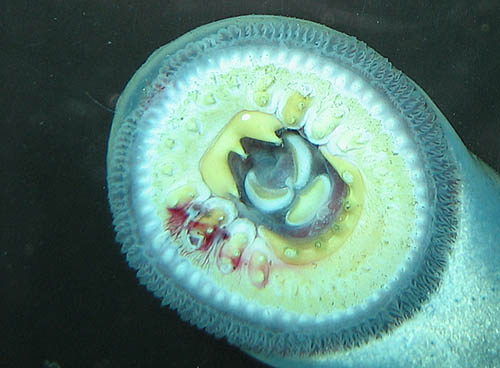
Sea Lamprey (Pacific, not Atlantic)

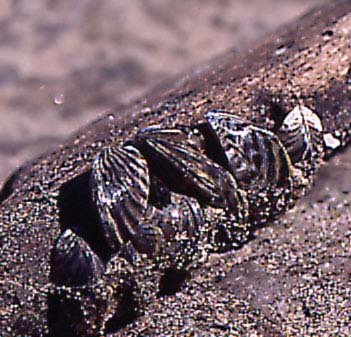
Zebra Mussels.
The zebra mussel (Dreissena polymorpha) entered Lake Erie around 1988, probably as a result of a ship from Europe discharging freshwater ballast upstream in Lake St. Clair a few years earlier. These mussels bind to virtually every hard substrate - rocks, pilings, boats, water pipes and intakes, even native mussels and large dragonfly nymphs! From these sites they filter the water for food, and are very efficient at removing algae and other suspended particles from the water. The apparent increase in clarity of Lake Erie from 1974 to 1995 in the graph at left is largely the result of huge numbers of zebra mussels. This has been a mixed blessing for the lake. Greater water clarity is good for some species, but many native species have been hurt and the overall effect remains to be seen - if it can ever be sorted out from the cascading effects of pollution, pollution control, and a parade of invasive species. One web page lists these invasive species for the great lakes: Cercopagis pengoi | Rusty Crayfish | Spiny Water Flea, Common Carp | Goby | Ruffe | Sea Lamprey | White Perch Zebra Mussel Curly-leaf Pondweed | Eurasian Watermilfoil | Flowering Rush | Purple Loosestrife - and there are a lot more.
Some species were perfectly happy in Lake Erie, even when it was polluted, once again the pronouncement of the "death" of Lake Erie was a bit premature. The cyanobacterium Plectonema woolei in turbid Lake Erie has virtually all the known accessory pigments. Grown under low-light conditions (it can grow in a refrigerator, apparently getting enough light when the door is opened occasionally) it is black in color. Its LCP in Lake Erie was often about 10 m, where visibility to the human eye was measured in cm. This cyanobacterium was well adapted for the turbid days in Lake Erie. A friend of mine was studying it, and as a result we spent a lot of time diving in the lake and looking for it, as well as trawling for it with our specially designed Plectonema sampler (below right). I often wonder what happened to the Plectonema now that the Lake is much clearer as the result of the zebra mussels?
What does all this tell us? Life adapts to whatever we throw at it. Pollutants, nutrients, invasive species - in all of these situations some organisms are able to survive, and, with their competitors and predators reduced by the disturbance, some of them can even thrive. The consequences of these changes, however, are usually not too obvious and rarely are to our benefit, and the effort required to clean up after ourselves is usually much greater (and more expensive) than it would have been not to create the mess in the first place. My dog knows not to go to the bathroom in its den (also known as our house) - will humans ever learn this basic fact that canines mastered hundreds of thousands of years ago?
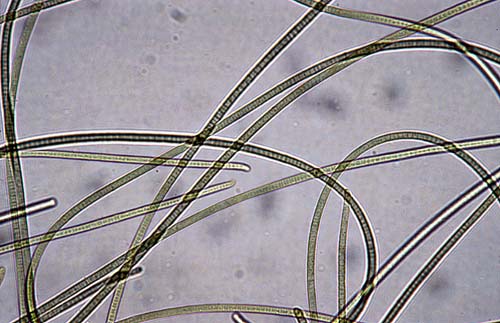
Oscillatoria sp.; a near look alike to Plectonema woolei.
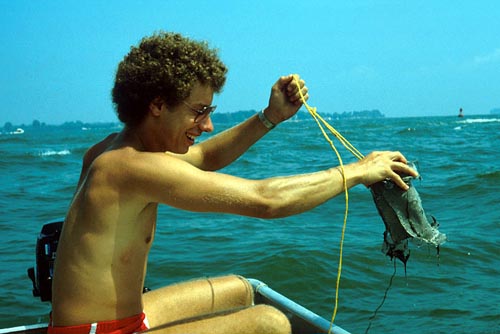
The world-famous Plectonema sampler. This device is now in the Smithsonian.




Horses: Smarter than they look!

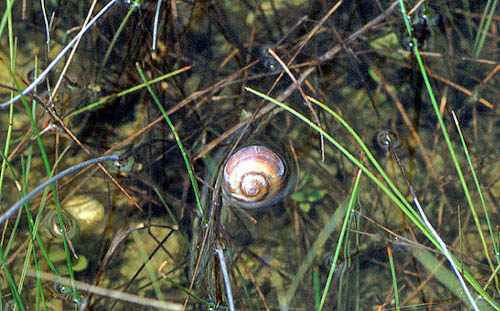
Apple Snail
The Apple Snail is a large snail that lives in the Everglades and the lakes of southern Florida. It can grow to the size of an apple, and is one of the main prey items in the diet of the endangered Snail Kite. The eggs are somewhat hard-shelled and laid above the waterline, both unusual for snails.
The Bullfrog, native to the eastern US, has been introduced all over the world, and in moist places it is an invasive pest. The largest frog in North America, it is voracious and rapidly consumes native species in the areas where it has been introduced. I had a captive specimen once, who, over the course of 3 years, ate a 6" long bass, hatchling chicks, raw hamburger, a baby snapping turtle, marshmallows, lettuce, and a bunch of other stuff. The bass and the turtle were accidents (in fact, the tadpole from whence the frog sprang was intended as food for the bass and I never thought it would eat the turtle); the lettuce and marshmallows were the results of bets (I was confident that, properly presented, the frog would eat anything) and the chicks are a long story.
Canada Geese were rare when I was a kid; now there are conferences on controlling them. Part of the change is due to a change in the geese themselves - fewer are migratory and more are staying resident in certain areas. By the way, snapping turtles eat goslings. An the circle is complete....
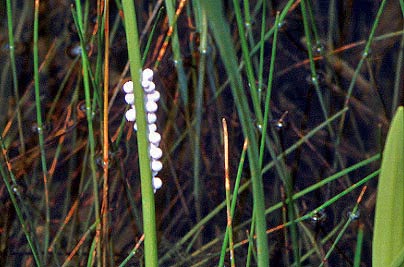
Apple Snail Eggs

Canada Geese (Branta canadensis)
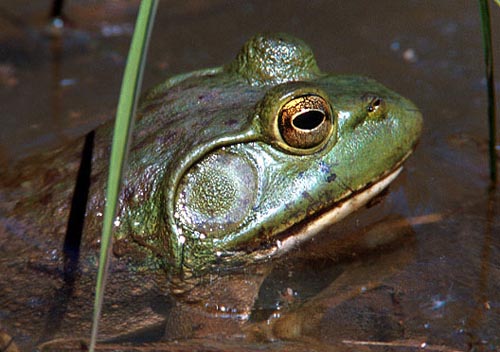
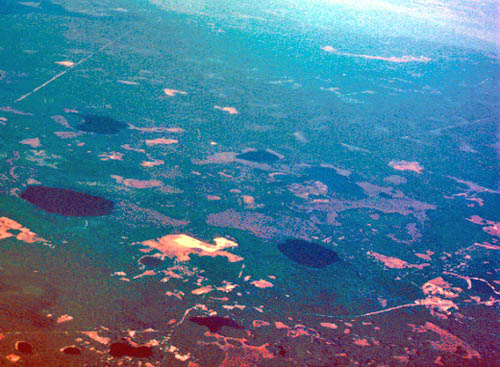
Florida landscape with circular sinkhole lakes.
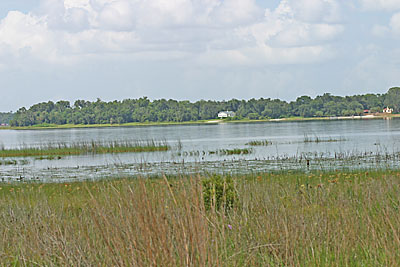
A sinkhole lake.
Lake Annie is one of the cleanest of the sinkhole lakes in Florida. Protected by its location as part of the Archbold Biological Station, it hasn't suffered from the cultural eutrophication that has affected many of the lakes in Florida. As the underwater pictures attest, the water is relatively clear. However, plant life is abundant, and the leaves waiting to decompose on the bottom are another source of nutrients waiting to be tapped. Indeed, diving in Lake Annie I have seen algal blooms suspended in the water column at places where the water density changes abruptly.
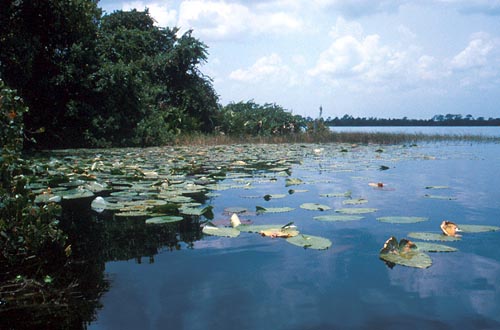
Lake Annie, a sinkhole lake at the Archbold Biological Station.
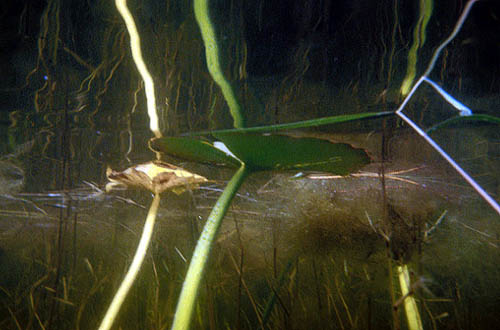
Underwater in Lake Annie.
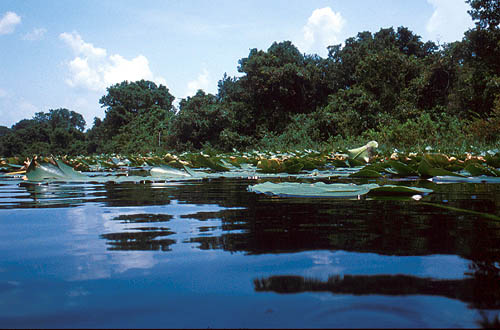
The surface of Lake Annie.
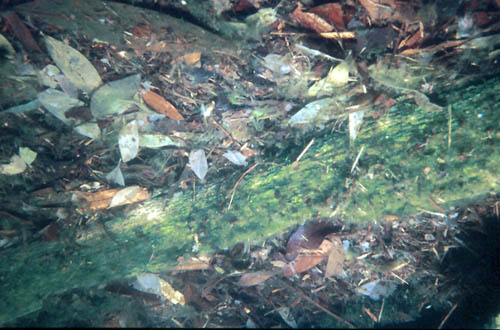

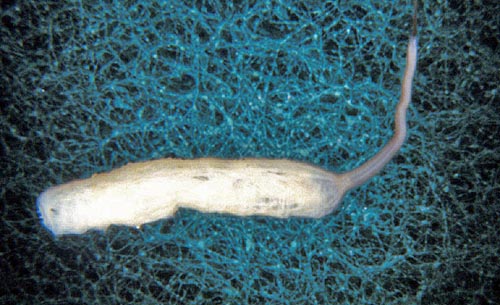 The
pond at the left (actually a turning basin on the Ohio and Erie Canal near
Coshocton, Ohio) is eutrophic. The green water, rich with planktonic
algae, as well as the floating mats of algae, are, in this
case, diagnostic. Such a pond supports quite a bit of life, but
there are places which are even more eutrophic. Sewage lagoons, say
on a pig farm, may be hypereutrophic. Dissolved oxygen levels
may be so low that the only organisms that can survive are those with
special adaptations for low oxygen levels, such as the Rat-tailed
Maggot (above). The "rat tail" of the maggot is
actually a "snorkel", an extension of the body bearing two
spiracles and attached air tubes through which the maggot breathes.
By extending the snorkel to the surface, the maggot can breathe a short
distance down into the anoxic, yet food-rich water.
The
pond at the left (actually a turning basin on the Ohio and Erie Canal near
Coshocton, Ohio) is eutrophic. The green water, rich with planktonic
algae, as well as the floating mats of algae, are, in this
case, diagnostic. Such a pond supports quite a bit of life, but
there are places which are even more eutrophic. Sewage lagoons, say
on a pig farm, may be hypereutrophic. Dissolved oxygen levels
may be so low that the only organisms that can survive are those with
special adaptations for low oxygen levels, such as the Rat-tailed
Maggot (above). The "rat tail" of the maggot is
actually a "snorkel", an extension of the body bearing two
spiracles and attached air tubes through which the maggot breathes.
By extending the snorkel to the surface, the maggot can breathe a short
distance down into the anoxic, yet food-rich water.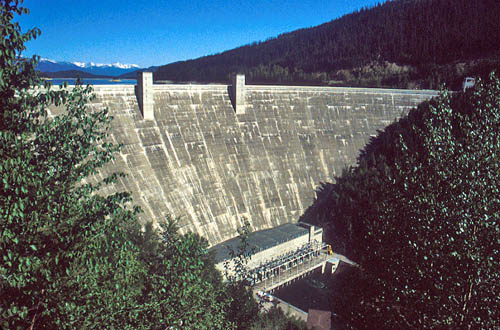
Hungry Horse Dam
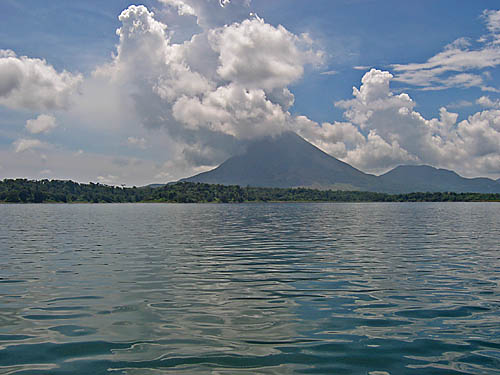


Bonneville Dam
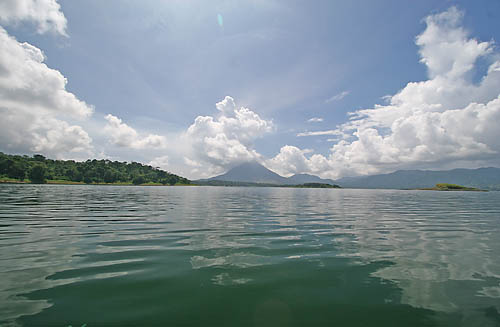
Lake Arenal
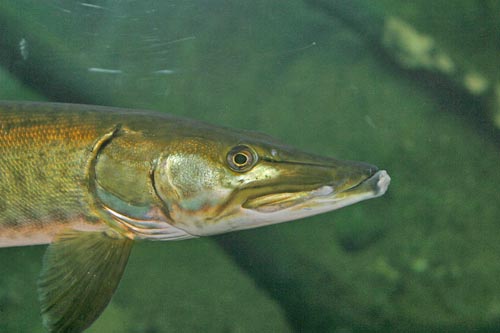
Pike
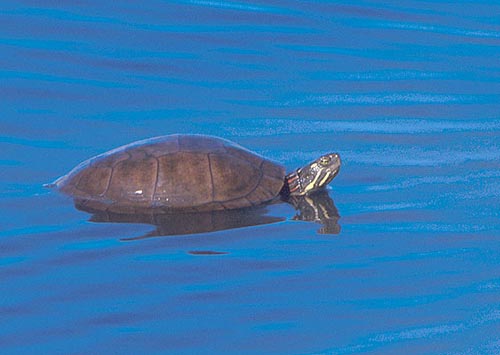
Painted Turtle, Chrysemys picta
Below are two pictures of Whirlygig Beetles (Gyrinidae, probably Dineutes). These beetles are fascinating for several reasons. First, they live between two worlds on the surface of the water, rowing rather rapidly with their flattened legs. Their two compound eyes are divided, with one set looking up at the aerial world and the other down underwater; predators could come from either direction. They secrete a chemical into the water to change the surface tension; this allows them to move faster and the Navy has studied them with an eye towards applying this to ships and submarines. Also, they are quite social, and produce an aggregating hormone which reportedly is similar to the aroma of Juicy Fruit gum. After handling the beetles, I'm more reminded of the smell of cucumbers, but that might be a defensive secretion I'm smelling.

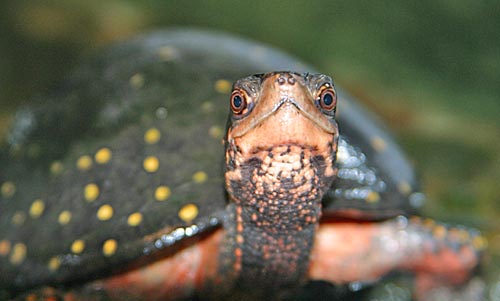
Spotted Turtle (Clemmys guttata)
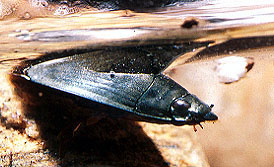
Whirlygig Beetles (Gyrinidae)
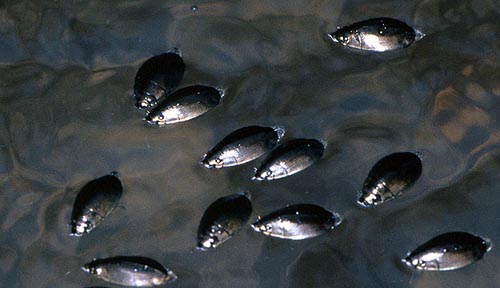
Whirlygig Beetles (Gyrinidae)




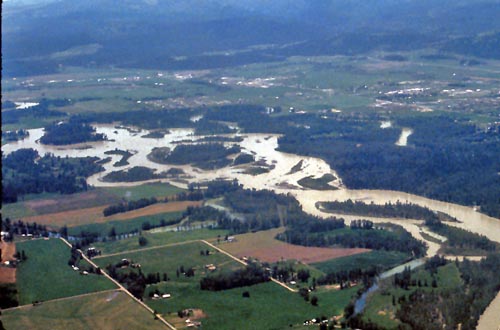
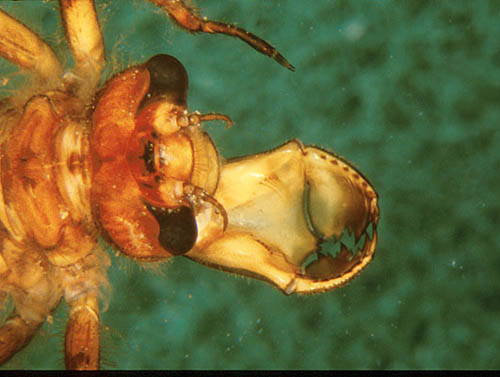
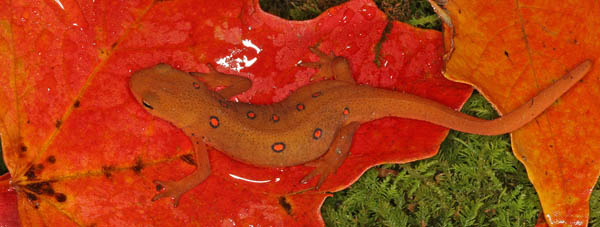
The dragonfly larvae to the left (Family Corduliidae) captures small prey items in the basket-shaped labial palp which can be extended forward from the face by hydrostatic pressure in the blink of an eye. Dragonfly larvae may be the top predators in some fishless ponds. Fishless ponds are also home to many other species, including unique insects, crustaceans and many species of amphibians including the red-spotted newt (Notophthalmus viridescens). Do wildlife a favor and don't transport fish to every little puddle you can find; we're never going to run out of bluegills but a lot of species depend on fishless ponds.
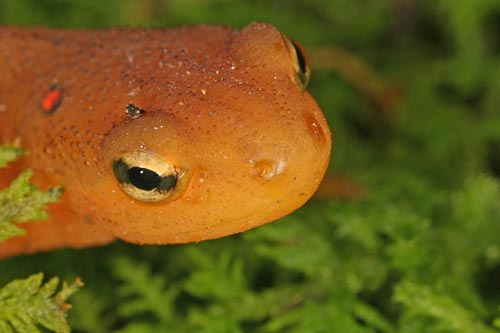

The Great Salt Lake

The Great Salt Lake
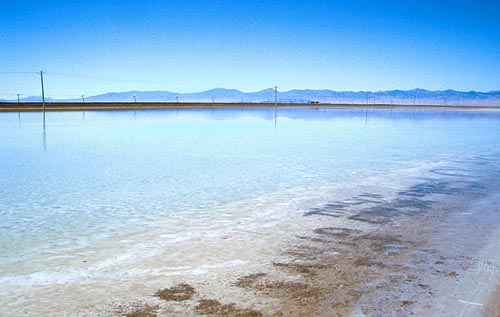
Finally, a real clash in habitats. The Great Salt Lake (above left), in Utah, is one of the saltiest bodies of water around. With no outlets, water flowing in from the surrounding mountains bring additional salts, which are left behind when the water evaporates. Most living organisms cannot tolerate the saltiness, but the are algae, crustaceans and insects which can, and these organisms make up the simple food chain of the lake. The dikes in the picture above divide up portions of the Great Salt Lake, and the coloration is caused by algae in the water.
The Great Salt Lake Food Chain
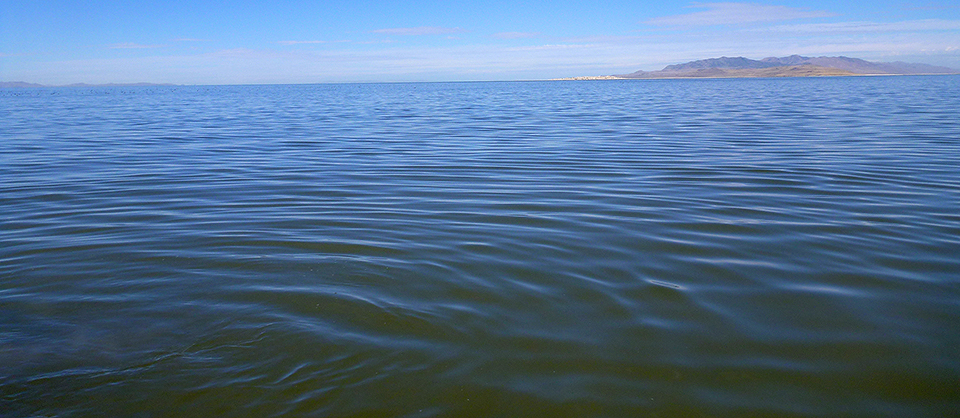
The base of the food chain in the Great Salt Lake is phytoplankton. In the Great Salt Lake the phtyoplankton include green algae, diatoms and cyanobacteria. You can see a green color caused by algae in the photo above; other algae in the lake are reddish in color. For instance, a railroad causeway runs across the middle of the lake and reduces water flow. The northern part of the lake is more saline and supports a large population of Dunaliella salina which is red in color. The southern part is less saline and the dominant algae is Dunaliella viridis, which, as the Latin name implies, is greenish. Dunaliella viridis probably dominates in the image above, and is likely responsible for the greens in the image below. The red colored areas in the image below are evaporation basins. These are diked off from the main part of the lake and allowed to dry out so minerals can be extracted; as a result they are saltier than the main part of the lake and probably harbor a lot of Dunaliella salina. Other algae live on the bottom of the lake as well and can be an important food source.

Algae in the lake are consumed by two main herbivores: brine flies and brine shrimp. These are the two main organisms able to live in the high salinity of the lake. The brine flies, below, emerge in huge numbers in the summer (the pictures below were taken in the fall when there were fewer flies and thus do not do this phenomenon justice). These flies remove a tremendous amount of organic material from the lake.
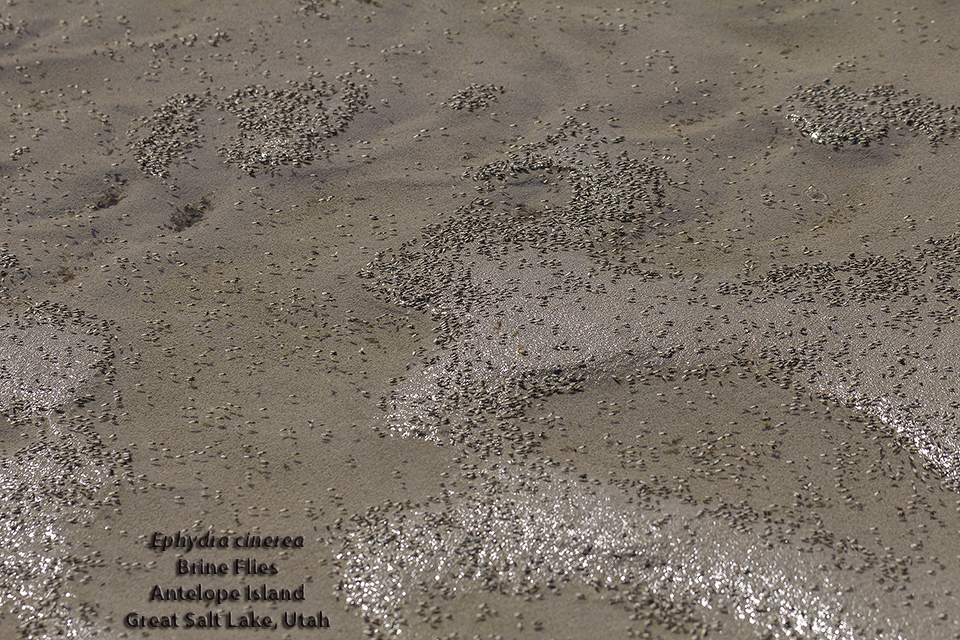

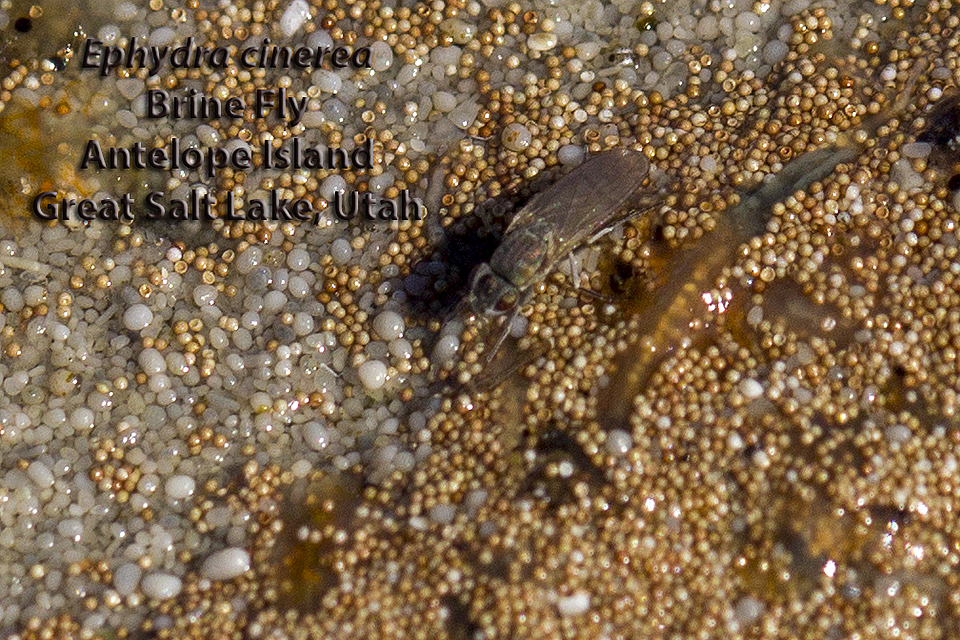
I don't have a picture of the larvae, which look like small maggots and live on the bottom of the lake. When it is time to transform to the adult stage, the larvae transform into pupae, which eventually make their way to the surface. The pupal case splits open and the adult flies away. The pupal skins then wash up on the shore (below) and decompose.
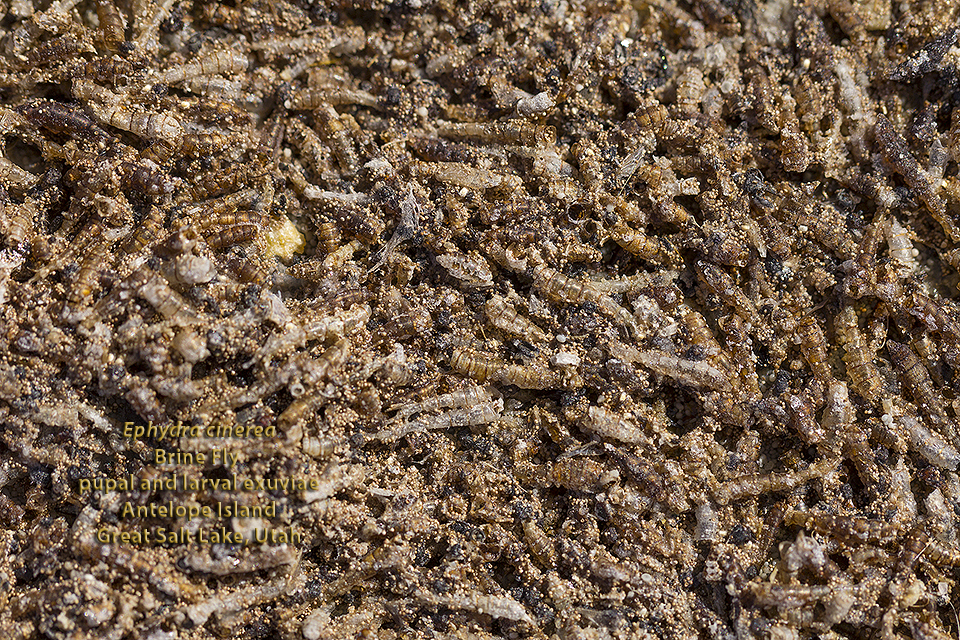
Once ashore, the brine flies provide food for birds and smaller creatures including this tiger beetle:

Tiger beetle larvae (below) live in borrows in the soil. The larvae uses the expanded top of its head to cover the entrance to its burrow; when a small insect such as a brine fly approaches it leaps out and grabs the prey. The species pictured below is not the same as the one seen at the Great Salt Lake; these larvae were found on the shores of Lake Erie.


The other (and more famous) inhabitant of the lake is the brine shrimp, which are also present in large numbers. This species, Artemia salina, is able to inhabit the salty waters of the lake, where it also feeds on algae. Towards fall, the females begin to encase their eggs in hard spherical cysts. These cysts are able to resist dessication, and are produced by the billions. Below, a female brine shrimp is shown amid a profusion of cysts (eggs). She has more eggs ready to lay in her Brood Sac. Some of the brine shrimp are bright red in color as a result of the algae they have ingested. Harvesting brine shrimp eggs is a large industry; the eggs are sold for use in feeding tropical fish and for pets - this is where we get Sea Monkeys from.

The Great Salt Lake is know for its saltiness. On the other extreme are springs, which often have few salts dissolved in the water. To the right is a picture of the extremely clear water in a Florida spring (the picture is of the bottom of the spring taken from about 2 meters away). To the lower right is a view of the water in the spring's outflow creek. Below is a new species of blind cave crayfish recently isolated from this cave system by Terrence Tysall of the Cambrian Foundation. A former Marietta Student, Amy Gianotti (MC 1995) (center, below) is the Vice President for Science and Research at the foundation, and also works for the Florida Department of Environmental Protection.




